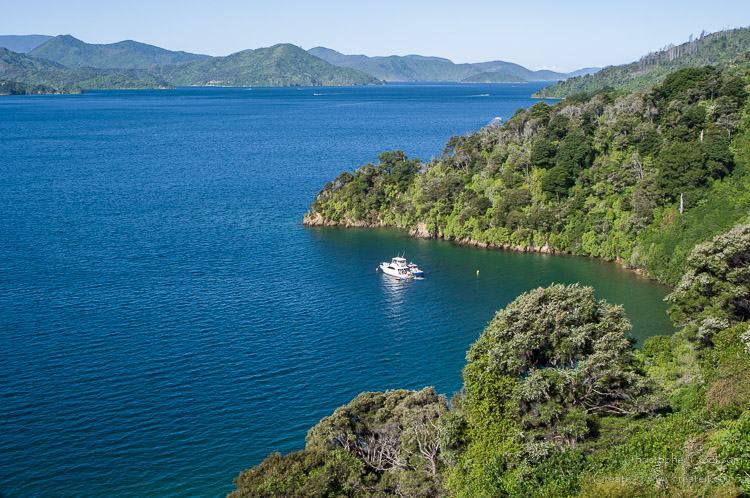Marlborough Sounds
Last Modified: 6-6-2021 21:04

© Christopher Cookson License this image
The Marlborough Sounds are a network of drowned valleys at the north-eastern tip of the South Island. Maori tradition speaks of the Marlborough Sounds as the shattered prow of an intricately adorned canoe by which the gods came from heaven. The Sounds were first visited by Europeans when Captain Cook spent time in Ship Cove near the entrance to Queen Charlotte Sound (Tōtaranui) in 1770.
Geography
The two largest sounds are Queen Charlotte Sound (Tōtaranui) in the east, and Pelorus Sound (Te Hoiere) to the west, separated by an area of low lying land at Linkwater. Numerous bays and inlets branch off each of these sounds, and the smaller Mahau and Keneperu sounds branch off Pelorus Sound. Over forty islands are found scattered throughout the Sounds ranging in size from thousands of hectares down to under a hectare.
The Sounds are one of only a few areas in New Zealand where the land is sinking into the sea.1 The Sounds are a continuation of the Richmond Range, which has tipped into the sea. The bedrock they consist of formed 280 million years ago and has moved 53km since the Pliocene 7.7 million years ago. Sedimentary, volcanic, and mineral belts are found in close proximity. Concentrated deposits of nickel, chromium, cobalt, molybdenum and manganese are found in the mineral belts, and cause stunting of vegetation at low altitudes. Movement continues northwards at a rate of 6.6mm per year. This movement is a result of the Sounds being on the boundary of the Pacific and Indo-Australian plates. This active geology has led to dramatic ridges rising out of the sea, and a sheltered marine environment.
Natural History
The rich environment of the Sounds provides a home to a diversity of marine life. Crabs, paua, kina, shrimps, starfish and anemones, blue mussels, and bladder kelp are all common. Over 200 species of fish and three sea mammals also inhabit the Sounds, including snapper, sting rays, blue cod, terakihi, moki, and in the outer reefs, grouper. Blue cod and snapper suffered from over fishing, however with effective management fish stocks are returning.
Several predator free islands in the Sounds are used for recovery programs for a variety of endangered species including the kakapo, tuatara, and giant weta. There are also several marine reserves where fishing is not permitted .On land, much of the Sounds are covered in regenerating bush after being cut over, however there are a number of reserves of original podocarps and broadleafed trees, lianas, orchids and ferns. Near the Anakiwa end of the Queen Charlotte Track, and in Tennyson Inlet there are particularly good areas of native forest.
Economic Activity
Commercial activities in the Sounds include greenshell mussel, oyster and salmon farming. Mussel farming is one of Marlborough's iconic industries, and an annual Mussel Festival is held at Havelock at the head of Pelorus Sound. The rich mineral deposits of the Sounds have encouraged past efforts at mining, including copper mining on D'urville Island, and gold mining at Cape Jackson.
The Sounds are a popular recreational area and tourist destination, with the spectacular Queen Charlotte Track running from Ship Cove to Anakiwa one of Marlborough's premier tourist attractions. Other walking tracks include the Nydia Track in Pelorus Sound a short loop track at Cullen Point, and the still to be completed Link Pathway between Havelock and Picton. Numerous campsites can be found throughout the Sounds, while several lodges and resorts cater to the higher end of the tourist market.
Strait Shipping and Kiwirail provide passenger and freight ferries that link the North and South Islands, with the southern connection in Picton. The shipping route passes through part of Queen Charlotte Sound, and Tory Channel. In addition to serving inter-island shipping, the deep water port at Picton is a popular destination for cruise ships. In February 1986 the Soviet cruise liner Mikhail Lermontov hit rocks at Cape Jackson and sank in Port Gore with the loss of one life. The wreck is now a popular dive destination.
Web Links
Cite this page
Marlborough Sounds. (2021) Retrieved May, 15, 2024, from https://www.marlboroughonline.co.nz/marlborough/information/geography/coastal-areas/marlborough-sounds